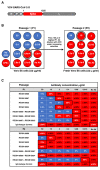Antibody cocktail to SARS-CoV-2 spike protein prevents rapid mutational escape seen with individual antibodies
- PMID: 32540904
- PMCID: PMC7299283
- DOI: 10.1126/science.abd0831
Antibody cocktail to SARS-CoV-2 spike protein prevents rapid mutational escape seen with individual antibodies
Abstract
Antibodies targeting the spike protein of severe acute respiratory syndrome coronavirus 2 (SARS-CoV-2) present a promising approach to combat the coronavirus disease 2019 (COVID-19) pandemic; however, concerns remain that mutations can yield antibody resistance. We investigated the development of resistance against four antibodies to the spike protein that potently neutralize SARS-CoV-2, individually as well as when combined into cocktails. These antibodies remain effective against spike variants that have arisen in the human population. However, novel spike mutants rapidly appeared after in vitro passaging in the presence of individual antibodies, resulting in loss of neutralization; such escape also occurred with combinations of antibodies binding diverse but overlapping regions of the spike protein. Escape mutants were not generated after treatment with a noncompeting antibody cocktail.
Copyright © 2020 The Authors, some rights reserved; exclusive licensee American Association for the Advancement of Science. No claim to original U.S. Government Works.
Figures


Similar articles
-
Studies in humanized mice and convalescent humans yield a SARS-CoV-2 antibody cocktail.Science. 2020 Aug 21;369(6506):1010-1014. doi: 10.1126/science.abd0827. Epub 2020 Jun 15. Science. 2020. PMID: 32540901 Free PMC article.
-
Potent neutralizing antibodies against multiple epitopes on SARS-CoV-2 spike.Nature. 2020 Aug;584(7821):450-456. doi: 10.1038/s41586-020-2571-7. Epub 2020 Jul 22. Nature. 2020. PMID: 32698192
-
Cross-neutralization of SARS-CoV-2 by a human monoclonal SARS-CoV antibody.Nature. 2020 Jul;583(7815):290-295. doi: 10.1038/s41586-020-2349-y. Epub 2020 May 18. Nature. 2020. PMID: 32422645
-
Targeting SARS-CoV2 Spike Protein Receptor Binding Domain by Therapeutic Antibodies.Biomed Pharmacother. 2020 Oct;130:110559. doi: 10.1016/j.biopha.2020.110559. Epub 2020 Aug 1. Biomed Pharmacother. 2020. PMID: 32768882 Free PMC article. Review.
-
Structural Basis of SARS-CoV-2 and SARS-CoV Antibody Interactions.Trends Immunol. 2020 Nov;41(11):1006-1022. doi: 10.1016/j.it.2020.09.004. Epub 2020 Sep 17. Trends Immunol. 2020. PMID: 33041212 Free PMC article. Review.
Cited by
-
COVID-19-vaccinated plasma treatment for COVID-19 patients?Influenza Other Respir Viruses. 2021 Jul;15(4):552-553. doi: 10.1111/irv.12852. Epub 2021 Mar 14. Influenza Other Respir Viruses. 2021. PMID: 33715284 Free PMC article. No abstract available.
-
Neutralising antibody escape of SARS-CoV-2 spike protein: Risk assessment for antibody-based Covid-19 therapeutics and vaccines.Rev Med Virol. 2021 Nov;31(6):e2231. doi: 10.1002/rmv.2231. Epub 2021 Mar 16. Rev Med Virol. 2021. PMID: 33724631 Free PMC article. Review.
-
Neutralizing activity of Sputnik V vaccine sera against SARS-CoV-2 variants.Res Sq [Preprint]. 2021 Apr 8:rs.3.rs-400230. doi: 10.21203/rs.3.rs-400230/v1. Res Sq. 2021. Update in: Nat Commun. 2021 Jul 26;12(1):4598. doi: 10.1038/s41467-021-24909-9. PMID: 33851150 Free PMC article. Updated. Preprint.
-
Antibody evasion by the P.1 strain of SARS-CoV-2.Cell. 2021 May 27;184(11):2939-2954.e9. doi: 10.1016/j.cell.2021.03.055. Epub 2021 Mar 30. Cell. 2021. PMID: 33852911 Free PMC article.
-
Mapping Neutralizing and Immunodominant Sites on the SARS-CoV-2 Spike Receptor-Binding Domain by Structure-Guided High-Resolution Serology.Cell. 2020 Nov 12;183(4):1024-1042.e21. doi: 10.1016/j.cell.2020.09.037. Epub 2020 Sep 16. Cell. 2020. PMID: 32991844 Free PMC article.
References
-
- Hansen J., Baum A., Pascal K. E., Russo V., Giordano S., Wloga E., Fulton B. O., Yan Y., Koon K., Patel K., Chung K. M., Herman A., Ullman E., Cruz J., Rafique A., Huang T., Fairhurst J., Libertiny C., Malbec M., Lee W.-y., Welsh R., Farr G., Pennington S., Deshpande D., Cheng J., Watty A., Bouffard P., Babb R., Levenkova N., Chen C., Zhang B., Romero Hernandez A., Saotome K., Zhou Y., Franklin M., Sivapalasingam S., Chien Lye D., Weston S., Logue J., Haupt R., Frieman M., Chen G., Olson W., Murphy A. J., Stahl N., Yancopoulos G. D., Kyratsous C. A., Studies in humanized mice and convalescent humans yield a SARS-CoV-2 antibody cocktail. Science 10.1126/science.abd0827 (2020). 10.1126/science.abd0827 - DOI - PMC - PubMed
-
- Lau S.-Y., Wang P., Mok B. W.-Y., Zhang A. J., Chu H., Lee A. C.-Y., Deng S., Chen P., Chan K.-H., Song W., Chen Z., To K. K.-W., Chan J. F.-W., Yuen K.-Y., Chen H., Attenuated SARS-CoV-2 variants with deletions at the S1/S2 junction. Emerg. Microbes Infect. 9, 837–842 (2020). 10.1080/22221751.2020.1756700 - DOI - PMC - PubMed
-
- Dieterle M. E., Haslwanter D., Bortz R. H. 3rd, Wirchnianski A. S., Lasso G., Vergnolle O., Abbasi S. A., Fels J. M., Laudermilch E., Florez C., Mengotto A., Kimmel D., Malonis R. J., Georgiev G., Quiroz J., Barnhill J., Pirofski L. A., Daily J. P., Dye J. M., Lai J. R., Herbert A. S., Chandran K., Jangra R. K., A replication-competent vesicular stomatitis virus for studies of SARS-CoV-2 spike-mediated cell entry and its inhibition. bioRxiv (2020). - PMC - PubMed
Publication types
MeSH terms
Substances
LinkOut - more resources
Full Text Sources
Other Literature Sources
Miscellaneous

